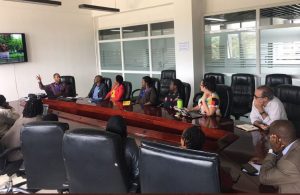KIGALI – Architects, urban designers, artists and allies in Kigali recently hosted Justin Garrett Moore, Executive Director of New York Public Design Commission [IG1], and discussed public spaces and public art with him.
Moore shared that art and culture are key drivers of New York City’s economy as good design of public spaces and quality of public art and cultural institutions makes city attractive to investors and brings more than 50 million tourists yearly. The New York City established its Public Design Commission since 1898 making sure that public buildings, public spaces and public art are of high level of quality and are contributing to the city being globally competitive for two centuries, at the same time acknowledging identities of various communities in the city.
In 1982 New York City passed the law where certain percentage of every publicly funded construction project goes for public art. Today that is 1 per cent [IG2] of total budget for every public project – whether building new or reconstructing existing hospitals, schools, police stations, libraries, bridges, streets, and other.
The Public Design Commission oversees more than 1,000 city projects yearly and percentage dedicated to creating public art in public spaces or public buildings contributes to development of local art community and provides access and exposure to art for all levels of society.
Moore highlighted the importance of involving communities in the planning and implementation phases for public spaces, and especially public art where spatial location is important, yet what message is art conveying and to which audience is the most important. He shared that New York City’s museums are strong supporters of public art and public spaces. During the discussion, Vivaldi Ngenzi, Manager of Rwanda Art Museum highlighted the need for cultural institutions to significantly contribute to Kigali’s image of cultural capital in the region.
Previous to discussion with Moore, the Ministry of Infrastructure chaired and Global Green Growth Institute co-chaired two Thematic Urbanisation Sector Working Group Meetings on Public Spaces [IG3] , with more than 50 different stakeholders ranging from Government agencies, development partners, academia, private sector to women and youth groups, when Patricie Uwase, Permanent Secretary of the Ministry of Infrastructure called for all sector stakeholders to fast-track their work on public spaces, and closely coordinate inputs.
An important message on collaboration repeated during the discussion with Moore where Edward Kyazze, Division Manager at the Ministry of Infrastructure and Dr Josephine Malonza, Lecturer at the University of Rwanda, chairing and co-chairing technical advisory group for the City of Kigali master plan revision, said that coordination among artists, local government, private companies, museums, and other stakeholders is crucial for good quality of public spaces and public art. The revised master plan of Kigali sees the city as “creative” in addition to other highlights.
For those of us who are passionate about public spaces, public art, and cities in general, and are trying to contribute and read regular updates on master plan revisions for Kigali and secondary cities, are looking forward to next year with full confidence that – the master plans 2050 would recognise public spaces and implementation plans would list them as priority projects, as it is already the case for District Development Strategies 2018-2024.

The views expressed in this article are of the author as written by Ilija Gubic , Sn Officer Green Infrastructure -GGGI Rwanda